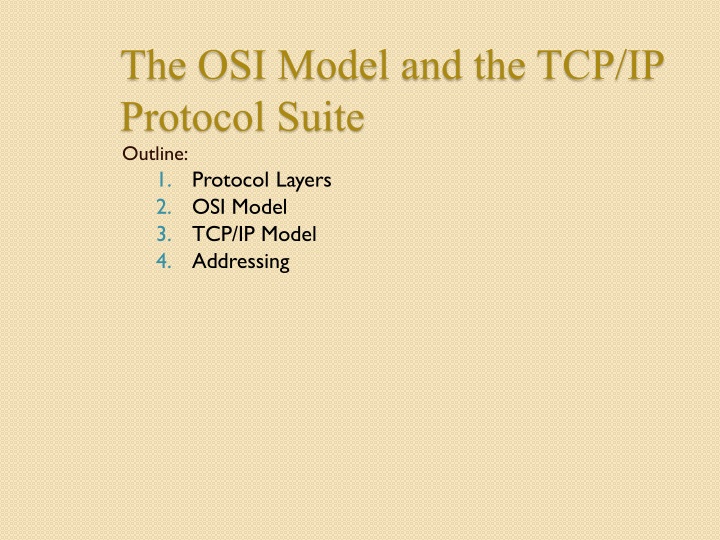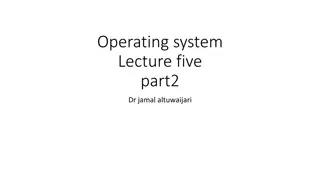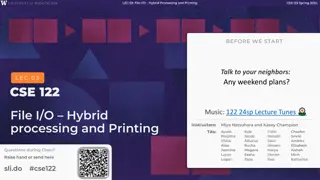
OSI Model and TCP/IP Suite Layers
"Explore the OSI model and TCP/IP protocol suite, diving into layers like application, presentation, and session that facilitate communication between network devices. Learn about the functions and responsibilities of each layer to enhance your understanding of networking concepts."
Download Presentation

Please find below an Image/Link to download the presentation.
The content on the website is provided AS IS for your information and personal use only. It may not be sold, licensed, or shared on other websites without obtaining consent from the author. If you encounter any issues during the download, it is possible that the publisher has removed the file from their server.
You are allowed to download the files provided on this website for personal or commercial use, subject to the condition that they are used lawfully. All files are the property of their respective owners.
The content on the website is provided AS IS for your information and personal use only. It may not be sold, licensed, or shared on other websites without obtaining consent from the author.
E N D
Presentation Transcript
The OSI Model and the TCP/IP Protocol Suite Outline: 1. Protocol Layers 2. OSI Model 3. TCP/IP Model 4. Addressing
Application Layer This layer relates to the services that enable the user to access the network. It provide user interfaces and support user applications or services, such as software for file transfers, database access, WWW, Sand e-mail. In other words, it serves as a window through which application processes can access network services. This would be the layer that a programmer uses to allow his application to access a network service, such as linking into a database. The major duties of this layer: mail services, file transfer and access, remote log-in, accessing WWW. Nouf Aljaffan (C) 2012 - CSC 1202 Course at KSU 3/19/2025
Communication at application layer A B Source Destination D Data H Header Application Application Legend Transport Transport R1 R3 R4 Network Network Data link Data link Physical Physical D5 D5 Message D5 D5 Message TCP/IP Protocol Suite 3
Note The unit of communication at the application layer is a message. TCP/IP Protocol Suite 4
Presentation Layer It is a layer in the OSI model. The presentation layer is responsible for translation, compression, and encryption. Deals with the actual formatting of the data. For example, data might be converted from EBCDIC to ASCII formatting so that the receiving node can understand it. Nouf Aljaffan (C) 2012 - CSC 1202 Course at KSU 3/19/2025
Session Layer It is a layer in the OSI model. the session layer, allows two applications on different computers to open, use, and close a connection called a session. (A session is a highly structured dialog between two workstations.) Functions: Dialog control It also makes sure the session is orderly establishing, which node transmits first, how long it can transmit, and what to do in case of an error. It performs name-recognition and other functions, such as security, that are needed to allow two applications to communicate over the network. Synchronization The session layer synchronizes user tasks by placing checkpoints in the data stream. The checkpoints break the data into smaller groups for error detection. It allows information of different streams, perhaps originating from different sources, to be properly combined or synchronized. An example application is web conferencing, in which the streams of audio and video must be synchronous to avoid so-called lip synch problems.It ensures that the person displayed on screen is the current speaker.
Summery of OSI Layers TCP/IP Protocol Suite 7
ADDRESSING Four levels of addresses are used in an internet employing the TCP/IP protocols: physical address logical address port address application-specific address. Each address is related to a one layer in the TCP/IP architecture TCP/IP Protocol Suite 8
Example 1: physical addresses 1 packet accepted 87 10 87 10 Data Data 4 TCP/IP Protocol Suite 10
Example 1: physical addresses In the previous figure a node with physical address 10 sends a frame to a node with physical address 87. The two nodes are connected by a link (a LAN). At the data link layer, this frame contains physical (link) addresses in the header. These are the only addresses needed. The rest of the header contains other information needed at this level. As the figure shows, the computer with physical address 10 is the sender, and the computer with physical address 87 is the receiver. The data link layer at the sender receives data from an upper layer. It encapsulates the data in a frame. The frame is propagated through the LAN. Each station with a physical address other than 87 drops the frame because the destination address in the frame does not match its own physical address. The intended destination computer, however, finds a match between the destination address in the frame and its own physical address.
Physical Address As we will see later, most local area networks use a 48-bit (6-byte) physical address written as 12 hexadecimal digits; every byte (2 hexadecimal digits) is separated by a colon, as shown below: 07:01:02:01:2C:4B A 6-byte (12 hexadecimal digits) physical address
Example 2: logical addresses 33 99 A P Data 2010 20 10 A P Data A P Data Physical addresses changed 95 66 A P Data 9566 A P Data 33 99 A P Data Physical addresses changed TCP/IP Protocol Suite 13
Example 2: logical addresses The previous figure shows a part of an internet with two routers connecting three LANs. Each device (computer or router) has a pair of addresses (logical and physical) for each connection. In this case, each computer is connected to only one link and therefore has only one pair of addresses. Each router, however, is connected to three networks. So each router has three pairs of addresses, one for each connection. The computer with logical address A and physical address 10 needs to send a packet to the computer with logical address P and physical address 95. We use letters to show the logical addresses and numbers for physical addresses, but note that both are actually numbers, as we will see in later chapters.
Note The physical addresses will change from hop to hop, but the logical addresses remain the same. TCP/IP Protocol Suite 15
Port address the purpose of ports is to uniquely identify different applications or processes running on a single computer and thereby enable them to share a single physical connection to a packet-switched network like the Internet. As we will see later, a port address is a 16-bit address represented by one decimal number as shown. 753 A 16-bit port address represented as one single number TCP/IP Protocol Suite 16
Example 3: port address Receiver Sender A P Data Data a j Data a j Data A P a j Data A P a j Data A P a j Data H2 A P a j Data H2 Internet TCP/IP Protocol Suite 17
Example 3: port address The previous figure shows two computers communicating via the Internet. The sending computer is running three processes at this time with port addresses a, b, and c. The receiving computer is running two processes at this time with port addresses j and k. Process a in the sending computer needs to communicate with process j in the receiving computer. Note that although both computers are using the same application, FTP, for example, the port addresses are different because one is a client program and the other is a server program.
Note The physical addresses change from hop to hop, but the logical and port addresses usually remain the same. TCP/IP Protocol Suite 19
References http://pluto.ksi.edu/~cyh/cis370/ebook/ch 05b.htm CSC 1202 2012-2013 Lecture Notes. Chapter 2 in TCP/IP Protocol Suite , 4th ed, Behrouz A. Forouzan




![Lec [2] Health promotion](/thumb/274962/lec-2-health-promotion-powerpoint-ppt-presentation.jpg)